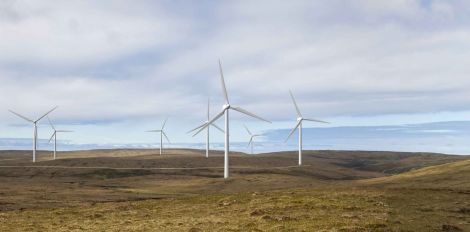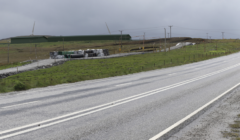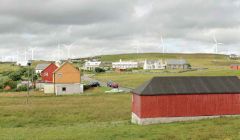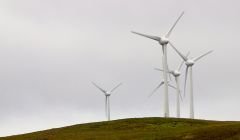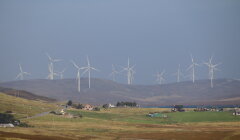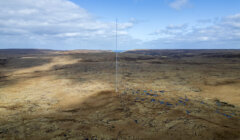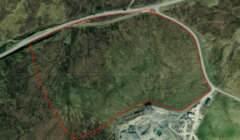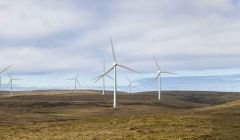Energy / Yell wind farm given green light by government
Statkraft hopes to start construction on the Energy Isles wind farm by 2025
THE PROPOSED Energy Isles wind farm in north west Yell has been given consent by the Scottish Government.
Developer Statkraft says the 18-turbine development, which would be located west of Cullivoe, could begin construction by 2025 – with the aim of having it operational by early 2027.
Energy Isles was the only proposed wind farm in Shetland remaining without consent.
With SSE’s Viking Energy wind farm under construction, Statkraft also has the go-ahead for Beaw Field in Yell, which would have 17 turbines, and the 12-turbine Mossy Hill on the outskirts of Lerwick.
Energy Isles would have a capacity of up to 126MW, and its turbines would stretch to 180 metres in height – larger than Viking Energy’s 155-metre turbines.
Statkraft’s principal project manager for Energy Isles Rebecca Todd said she was delighted that the wind farm has received consent, adding that it will create a “significant amount of renewable electricity, while improving energy security”.
The developer says the wind farm has the potential to generate enough renewable electricity to power the equivalent of 157,000 homes.
The approval for the project has come from the Scottish Government’s Energy Consents Unit because it is more than 50MW in capacity.
The decision letter says the “overall impacts to peatland habitats and the significant landscape and visual impacts are acceptable subject to conditions being imposed”.
It adds: “Overall the Scottish ministers consider that the proposed development will provide carbon savings, and that these savings will be of an order that weighs in favour of the proposed development and will contribute to the Scottish Government’s strategic priorities.”
The roots of Energy Isles stem back to 2012, when a consortium of mainly Shetland-based businesses came together to work on a project which would see the benefits from the emerging renewable sector retained “as far as possible” within the isles.
Become a member of Shetland News
Norwegian energy giant Statkraft was then announced as the development partner in 2019, to work on the project through to, and including, operation.
The project is expected to generated £17.3 million of investment in Shetland during development and construction, with £18.9 million of community benefit for the local area in the pipeline over the wind farm’s lifetime.
Todd said: “This would not have happened without the vision of Shetlanders who started this ambitious scheme back in 2012 and who have supported it all the way through.
“We’d like to thank the people of Shetland and the Energy Isles consortium for their drive and determination to decarbonise the North Isles and the hard work and backing for the project that they have provided.”
Derek Jamieson, from Energy Isles Ltd, said: “The strong support of local folk, including the businesses involved in Energy Isles Limited and supporters in the communities in the North Isles, has been fundamental to this outcome.
“We’re very glad that the Scottish Government has recognised how important this project is to sustainability of peerie island communities like ours looking to build towards a greener future.”
Through the planning process the project had drawn some concern among consultees for its impact on blanket bog.
The plans have been scaled down in stage over recent years through an engagement process, however, and both SEPA and NatureScot for instance withdrew objections subject to planning conditions.
Highlighting how much the proposals have changed over the years, Energy Isles was initially envisaged to feature 63 turbines.
At one point the project was proposing turbines of 200 metres from ground to blade tip, but that has been reduced to 180 metres.
The government’s decision letter added that “Scottish ministers are satisfied that the proposed development has been designed to minimise impacts on priority peatlands and compensation for the disturbance and loss of blanket bog will come in the form of the provision of a scheme for off-site restoration”.
It also said: “The Scottish ministers acknowledge that the proposed development would result in some impacts, which are considered acceptable in the context of the benefits and positive effects that the proposed development will bring in terms of net economic benefit, contributing to renewable energy and climate change targets.
“The Scottish ministers in making their determination on the application, have had to balance the above considerations, decide what weight is to be given to each and reach a view as to where the balance of benefit lies. On balance, it is considered that the proposed development is acceptable.”
Meanwhile Shetland Islands Council announced earlier this year that it would be entering into negotiations with Statkraft and partners to agree a lease for the land around the disused Scatsta Airport future energy production.
Become a member of Shetland News
Shetland News is asking its many readers to consider paying for membership to get additional features and services: -
- Remove non-local ads;
- Bookmark posts to read later;
- Exclusive curated weekly newsletter;
- Hide membership messages;
- Comments open for discussion.
If you appreciate what we do and feel strongly about impartial local journalism, then please become a member of Shetland News by either making a single payment, or setting up a monthly, quarterly or yearly subscription.






